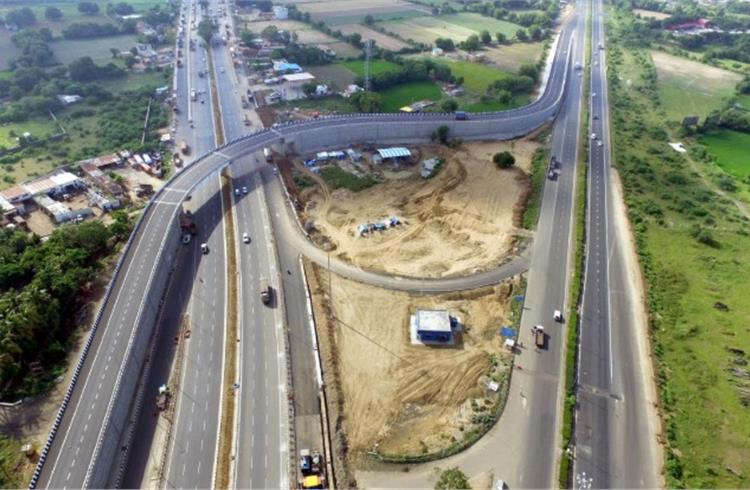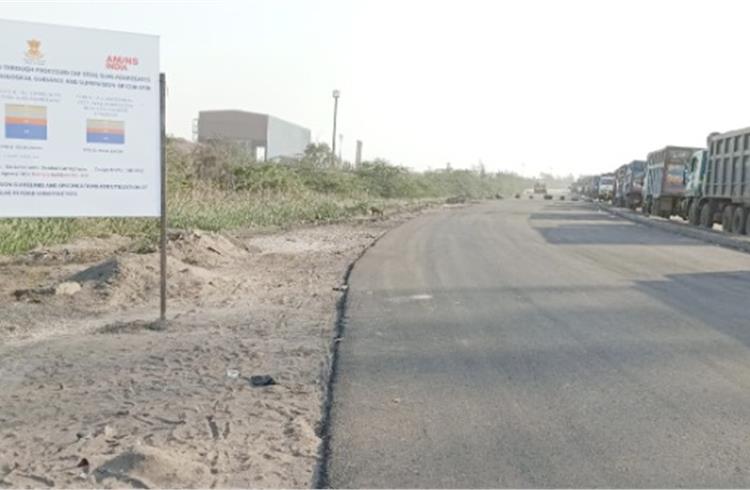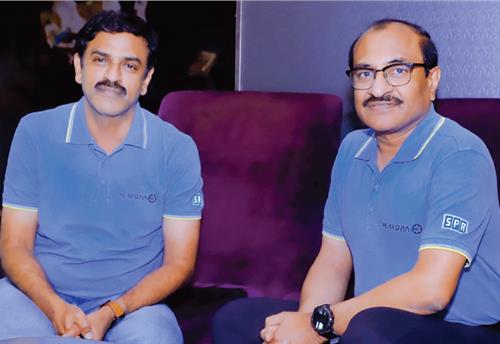INDIA@75: India’s roads take a great leap forward
As India celebrates its 75th year of its ' tryst with destiny' , its road network is in take-off mode with new highways and expressways being built.
It was May 18, 2002 and the conference hall at the Bengaluru International Exhibition Center (BIEC) was jammed packed. Lt Gen Rajeev Chaudhry, VSM, Director General, Border Roads Organisation (BRO) rose to address the gathering at Excon, a construction equipment industry event. After the customary pleasantries, he came straight to the point stressing on the significance of roads and highways in the development of a country.
To emphasise his point, Lt Gen. Chaudhry referred to India and South Korea, two nations that won independence from foreign rule around the same time. While India had it on August 15, 1947; South Korea got it a year later. For the first 10 years, he said, the destinies of the two nations remained almost similar with poverty, lack of industrialisation and lower development indexes. The GDP per capita of both the countries was almost similar at around $ 82-84 at the start of the 1960s.
However, the economic trajectories of both countries, however, soon began diverged in the subsequent years and decades. Even as the Cold War between US and Russia was beginning to touch new heights, India and South Korea chose two different directions. Under President Park Chung-hee, South Korea embarked on an infrastructure development constructing grand highways and expressways across the length and breadth of the country, as it put in place its policy for an export-driven economy. Chung-hee's was at the helm till his death in in 1979 but during that time, the country's development in the economic and social sphere continued despite the relative lack of natural resources.
The result: South Korea currently gets counted amongst the highly developed countries boasting GDP per capita of close to $31,000 with projections to exceed $ 41,000 in the next few years. In comparison, India is behind at $ 2200 at present. " That's the importance of infrastructure, especially of roads" said Lt Gen Chaudhry during his speech which had an audience comprising members of the construction equipment industry, senior members of armed forces, bureaucrats, and others.
n the other side of the world, the US embarked on its own highway building plan when President Dwight D. Eisenhower signed into law the Federal inter-state bill. It has been suggested that he used as a model of Germany's Reichautobahnen network of rural superhighways, that was admired by American engineers during the pre-war 1930s.
Golden Quadrilateral
It can be argued that India’s own road building network began in 1999 when the then PM, Atal B Vajpayee instituted the Golden Quadrilateral project which aimed to link the four major metros with a network of four-lane highways. A year later, he also kicked off the rural roads project under the name Pradhan Mantri Gram Sadak Yojana. The PMGSY was launched with the objective of providing unrestricted all-weather road connectivity to unconnected villages of India. It was a centrally sponsored scheme and part of the poverty reduction strategies of the government.
Soon after, the Pune-Mumbai expressway was opened to traffic in 2001 reducing the time from Mumbai to Pune by half to about three hours. As one businessman put it wryly, “One can now actually go to Lonavla for lunch.” The GQ continued to be built and was completed in 2012.
India’s business has always been challenged by congested roads which have led to inordinate delays in railway freight movement and long turnaround times. This has impacted logistics where the country has the distinction of being the one of the highest in terms of global costs. And while the raison d’etre for building better roads is no brainer, cost escalations on account of delays in land acquisitions, bureaucratic red tapism, and political slugfests have led to delays in building such projects.
Despite its many failings, road transport still remains as one of the most cost effective and convenient modes of transportation for freight and passengers as it has a high penetration level with door-to-door delivery. Typically, OEMs use road transport to ferry their cars to their warehouses and dealerships before rising fuel prices led to some companies like Maruti opting for the railways.
About 90 percent of passenger traffic and 65 percent of freight currently use road transports. The road network which comprises national highways, state-highways ,district roads, rural roads, urban roads and project roads works out to a total of 63.71 lakh km as on fiscal 2019, the second-largest in the world, after the USA with 66.45 lakh kms of roads. The extent of road construction per day has also increased substantially in India in recent years touching 36.5 kms per day in the fiscal 2020-21 in comparison to earlier years when it was nothing to boast about.
Greenfield projects
The current government has also initiated the Bharatmala, which is loosely termed as India's flower garland project, and is centrally-funded. The emphasis has been on development of highways and expressways which in recent years has seen a variety of greenfield expressway link the major cities such as Mumbai-Delhi, Delhi-Amritsar-Katra, Kanpur-Lucknow, Amritsar-Jamnagar and Bengaluru- Chennai which are at different stages of developmental work and are expected to makes these cities and towns through which these corridors passes into magnets of economic and social growth.
Among the more recent examples of what road and related infrastructure could do to change society are the BIMARU states which have seen a huge improvement over the last decade in the types of roads that are being built. These are the states in the north such as Bihar, Madhya Pradesh, Rajasthan and Uttar Pradesh that have seen increased economic activity due to the building of such road links.
The developments in infrastructure-related activities is also important from the point of view of the country achieving its target of reaching $ 5 trillion GDP economy by 2025. For this, the country needs to invest around $1.4 trillion by 2024-25 in order to achieve a gross domestic product (GDP) of $5 trillion by 2024-25, the Economic Survey 2022. While this looks like a tall task, it is though not outright impossible, considering the fact that during FY 2008-17, India could invest about $1.1 trillion in infrastructure.
Conducive policies
The significant upturn in road construction could also be attributed to the increase in public expenditure. For example, public expenditure increased by 29.5 percent in fiscal 2021 as compared to the previous year, a reflection of the government’s impetus to a critical sector that generates jobs supports infrastructure.
With the transport sector expected to attract more than 60 percent of all infrastructure related investments in India, even the private and institutional investors don't seem to want to miss the bus. To put things into perspective, infrastructure activities accounted for 13 percent share of the total foreign direct investment inflows of $ 81.72 billion in fiscal 2021 according to statistics available with the Department of Commerce, Union Ministry of Commerce and Industry. For India, investments in infrastructure equal to 1 percent of GDP will result in GDP growth of at least 2 percent as infrastructure has a "multiplier effect" on economic growth across sectors.
However, the challenge is to step up infrastructure investment substantially. Keeping this objective in view, the government launched the National Infrastructure Pipeline (NIP) with projected infrastructure investment of around Rs 111 lakh crore ( USD 1.5 trillion) for the period FY 2020-2025 to provide world-class infrastructure across the country, and improve the quality of life for all citizens.
The NIP also envisages the improvement of project building and attract investment, both domestic and foreign in infrastructure. The NIP was launched with 6,835 projects, which has expanded to over 9,000 projects covering 34 infrastructure sub-sectors. During the fiscal years 2020 to 2025, sectors such as energy (24 percent), roads (19 percent), urban (16 percent), and railways (13 percent) will account for around 70 percent of the projected capital expenditure in infrastructure in India. The NIP has taken into account all the stakeholders for a coordinated approach to infrastructure creation in India to boost short-term as well as the potential GDP growth.
The lawmakers have also suggested that a robust asset pipeline has been prepared to provide a comprehensive view to investors and developers of the investment avenues in infrastructure. The pipeline of projects includes brownfield assets with a stable revenue generation profile which will make for an attractive investment option. Total indicative value of NMP for core assets of the Central Government has been estimated at Rs 6 lakh crore over a four-year period which is about 5.4 percent of total infrastructure investment envisaged under NIP.
Asset monetisation
In India, the National Highway Authority of India (NHAI), a central agency under the union ministry responsible for construction of national highways in the country plans to monetise 5,500km of stretches in fiscal 2022–23, 7,300 km in fiscal 2023–24 and 8,900 km in fiscal 2024–25. With most projects during the period over the FY08-15 being awarded on the Build-Own-Transfer OT model, the NHAI was apparently able to garner significant funds through private sector participation. Further, with the budgetary support from the government in the form of cess, it was considered to be just sufficient enough for NHAI to meet the rest of the funding gaps. The premier road agency borrowed just about Rs 1200 crore annually on average during FY06–10.
However, with the toll model not finding many takers in later years , the dynamics seemingly changed for the NHAI, developers and other stakeholders changed. This prompted NHAI to raise its borrowings from over Rs 5500 crore in fiscal 2011–15 to Rs 51,000 crore over fiscal 2016-21. As a result, the NHAI’s overall debt, which was just under Rs 25,000 crore in fiscal 2015 touched Rs 340000 trillion by the end-Q3 2022. Its debt to equity, which was 0.2x in fiscal 2015 is now at 1.06x.
To counter this, the government has increased budgetary support for the road sector by way of cess and plough back of tolls, by about 30 percent in fiscal 2021 on an annual basis. It is further expected to touch 36 percent YoY in fiscal 2022 and 55 percent in the current fiscal respectively. On the other hand, incremental borrowings are projected to decline from Rs 75,000 crore in FY20 to Rs 65,000 crore each in fiscal 2021 and 2022. In fact, the entire outlay for the NHAI in the ongoing fiscal is likely to accrue from budgetary support with nil borrowings. Nevertheless, there are limits to increasing budgetary support, particularly considering that the cess on petrol and diesel forms the biggest chunk of government budgetary support.
Eco-friendly roads
While land acquisition and funding are among the many challenges that face road building, there is also a political aspect to the road construction activities. Road-building is the joint responsibility of the central government and each state, and the Centre , it has been suggested, rewards states which are politically aligned with the ruling party.
Road building requires coordination between states and central government to get around obstacles like land acquisition, planning permission and vetting of tenders – all of which can delay projects potentially and lead to huge cost overruns. The need for eco-friendly roads infrastructure is another aspect. Studies suggest that the reuse of waste polymers is among one of the attractive solutions and which reduce the costs of road pavement and maintenance.
Recently, GR InfraProjects ordered its first consignment of steel slag, a by-product of the steel-making process to build a 37-km portion of the Mumbai-Ahmedabad expressway. This is the first time that steel slag is being used to build a national highway project in the country. Steel slag is an environment-friendly and cost-effective alternative to natural aggregate in road construction and also offers other additional benefits over natural aggregates. It is an ideal aggregate material due to its good shape factor, high abrasion resistance, and excellent skid resistance properties. It also has a higher load- bearing capacity compared to natural aggregates, making it more durable.
RELATED ARTICLES
BRANDED CONTENT: Eliminating the worries of battery charging with smart solutions
The charging infrastructure is the backbone of electric mobility but is also one of the key perceived barriers to EV ado...
The battery-powered disruptor
Greenfuel Energy Solutions is planning to shake up the EV battery market with the launch of a portfolio of specially eng...
SPR Engenious drives diversification at Shriram Pistons & Rings
The engine component maker is now expanding its business with the manufacturing of motors and controllers through its wh...





 15 Aug 2022
15 Aug 2022
 8980 Views
8980 Views










 Autocar Pro News Desk
Autocar Pro News Desk




